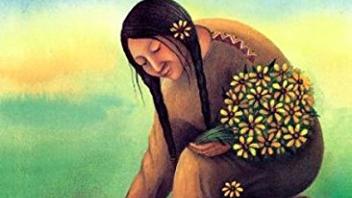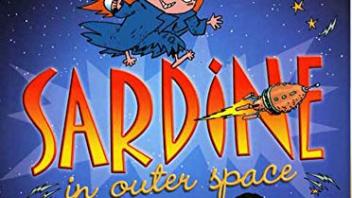
Books by this author

Like most Lakota Sioux boys, Slow yearns for the special vision or manly deed that will inspire his permanent, adult name. Encouraged by splendid stories of his father’s bravery, wisdom and leadership, Slow focuses his energy on becoming a warrior. Friends gradually begin to associate his name with careful deliberation. When the moment of his manhood arrives, Slow rides heroically against Crow warriors, earning the name Tatan’ka Iyota’ke (translated, on the final page, as Sitting Bull). — Publishers Weekly
A Boy Called Slow

Bruchac frames 11 legends of Native American sacred places with a conversation between Little Turtle and his uncle, Old Bear, who says, “There are sacred places all around us…They are found in the East and in the North, in the South and in the West, as well as Above, Below, and the place Within.”…The text is printed in stanzas, enhancing the image of prose poems.
Between Earth and Sky: Legends of Native American Sacred Places

For thousands of years, massive herds of buffalo roamed across much of North America, but by the 1870s, fewer than fifteen hundred animals remained. With reverent care, Walking Coyote and his family endeavored to bring back the buffalo herds, one magnificent creature at a time. Here is the inspiring story of the first efforts to save the buffalo, an animal sacred to Native Americans and a powerful symbol of the American West.
Buffalo Song

In this coming-of-age story, the children of the longhouse are 11-year-old Ohkwa’ri and Itsi:tsia. Twin brother and sister, they live in a Mohawk town in the traditional homelands of what is now eastern New York State in 1491. Reflecting the balance between male and female roles in Iroquois society, the book’s chapters alternate between the events and perspectives of Ohkwa’ri and Itsi:tsia, who very definitely see things differently. Bruchac seamlessly incorporates an impressive amount of information about pre-contact Mohawk culture, society, and beliefs, and tells a good story as well. — Oyate
Children of the Longhouse

Product Description: Joseph Bruchac tells the compelling story of how a young boy named Curly seeks a vision in the hope of saving his people — and grows into the brave and fierce warrior Crazy Horse. Sioux artist S. D. Nelson’s paintings, in the traditional ledger style of the Plains Indians, evokes the drama and the tragedy of this important American figure.
Crazy Horse’s Vision

In Dog People: Native Dog Stories, the voice of an Abenaki storyteller takes children back 10,000 years to the days when children and dogs had especially close relationships. In these Native American adventure stories, children and dogs together must use their wits to survive the dangers of the natural world. — Midwest Book Review
Dog People: Native Dog Stories

Danny Bigtree’s family has moved to a new city, and Danny can’t seem to fit in. He’s homesick for the Mohawk reservation, and the kids in his class tease him about being an Indian — the thing that makes Danny most proud. Can Danny, drawing on his Mohawk heritage, find the courage to stand up for himself?
Eagle Song

When Bear brags and Chipmunk teases, the results are an angry bear and a striped chipmunk. Animated language and colorful illustrations tell a Native American pourquoi story — a tale that explains why — that’s perfect for sharing aloud.
How Chipmunk Got His Stripes

In Native cultures, the night is a crucial part of the Great Circle and balance in the universe. In the tradition of the best-selling Keepers of the Earth and Keepers of the Animals, this collection offers unique ideas about understanding the natural world by looking at it through a nocturnal lens. Resources and activities include legends and myths, puppet shows, stargazing guides, campfire topics, and traditional dances.
Keepers of the Night: Native American Stories and Nocturnal Activities for Children

An important credo of Native life states that you can learn while you play and play while you learn. Readers can pore over intriguing stories and play these fun-filled games as they learn how global thought and beliefs can transcend their own lives. Sample themes, stories, and games include the Ball Players in the Sky (Passamaquoddy); Gluskabe Brings the Summer (Abenaki); and Nanabush and the Ducks (Anishinabe).
Native American Games and Stories

On the night of November 20, 1969, eighty-nine young Native American activists crossed the San Francisco Bay under cover of darkness, calling themselves the “Indians of All Tribes.” Their objective? To claim the former prison island of Alcatraz, basing their actions on an 1868 treaty that said abandoned federal land could be returned to Indigenous peoples. Taking a stand on an island reclaimed as “Indian Land,” these peaceful protestors brought worldwide attention to the issues facing present-day Native Americans, as well as the centuries of unjust federal Indian policy.
Of All Tribes: American Indians and Alcatraz

Bruchac adapts seven traditional tales from various tribes into plays for children. Each play is introduced with a brief tribal background, a list of characters, suggestions for props and scenery, and recommended costumes. Representing tribes from Bruchac’s own Abenaki to the Cherokee, Tlingit, and Zuni, the plays are mostly pourquoi tales, explaining how mosquitos came into the world or why stars are visible at night.
Pushing up the Sky: Seven Native American Plays for Children
Find this author’s books on these booklists
Themed Booklist
Mother Earth in Autumn
Themed Booklist
Native American Traditional Tales and Legends
Themed Booklist

